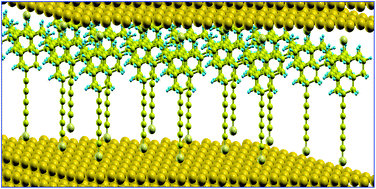Enhanced oscillatory rectification and negative differential resistance in pentamantane diamondoid–cumulene systems
Abstract
We propose a new functionality for diamondoids in nanoelectronics. Based on the nonequilibrium Green's function formalism and density functional theory, we reveal that when attached to gold electrodes, the pentamantane–cumulene molecular junction exhibits large and oscillatory rectification and negative differential resistance (NDR) – depending on the number of carbon atoms in cumulene (Cn). When n is odd rectification is greatly enhanced where the rectification ratio can reach ∼180 and a large negative differential resistance peak current of ∼3 μA. This oscillatory behavior is well rationalised in terms of the occupancy of the carbon 2p states in Cn. Interestingly, different layers of C atoms in the pentamantane molecule have different contributions to transmission. The first and third layers of C atoms in pentamantane have a slight contribution to rectification, and the fifth and sixth layers have a stronger contribution to both rectification and NDR. Thus, our results suggest potential avenues for controlling their functions by chemically manipulating various parts of the diamondoid molecule, thus extending the applications of diamondoids in nanoscale integrated circuits.


 Please wait while we load your content...
Please wait while we load your content...